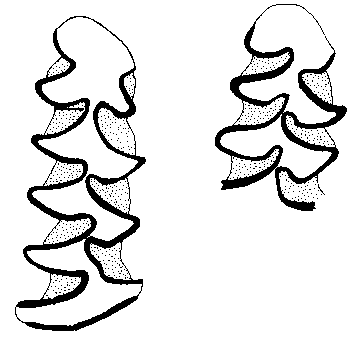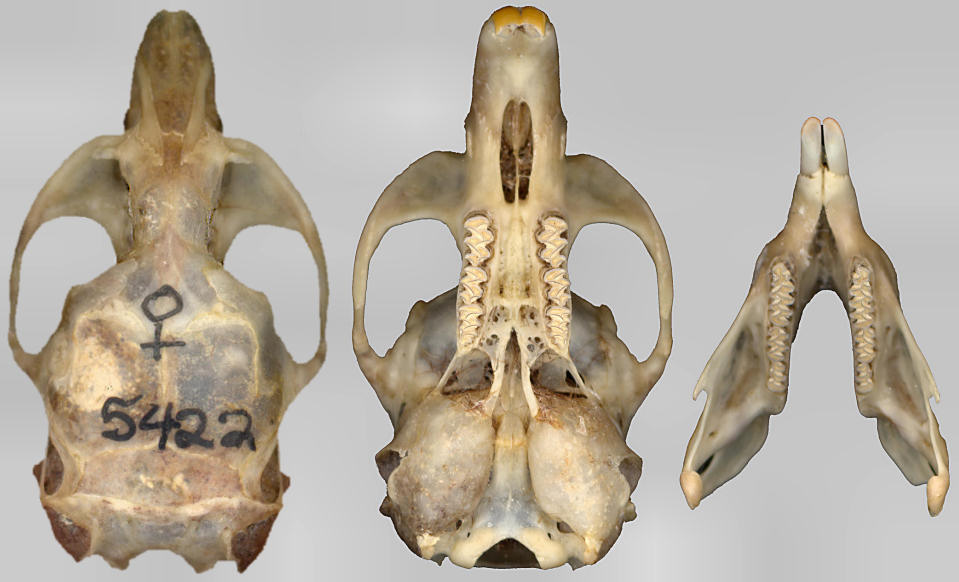The Arvicolinae include the voles and relatives (such as muskrats, lemmings, and bog lemmings). This is a predominantly northern group, though a few members have gotten into the tropics or semitropics. As a group with primarily northern affinities, taxa in the Southwest are mainly montane dwellers, though geographically widespread species descend to low elevations in wetter and/or cooler climates. The montane arvicolines from the mountains of central and southern New Mexico are isolated remnants of wider distributions during the late Pleistocene.
All of the arvicolines have relatively complex, prismatic cheek teeth. Most species have hypselodont (rootless, evergrowing) molars, but some have hypsodont, rooted teeth, including
Phenacomys and Ondatra. The hypselodont taxa are primarily grazers and thus normally are associated with grasses. 
Fig. 1 (left). Occlusal view of a first lower molar of Microtus ochrogaster (left) and anterior end of a first lower molar of other species of Microtus in New Mexico. White = dentine; black = enamel; stippled = cement.
Fig. 2 (below). Dorsal and ventral views of the skull and dorsal view of the mandible of the Mogollon Vole (Microtus mogollonensis). All regional voles look similar overall.

Eight species are known from New Mexico (none from Trans-Pecos Texas or northern Chihuahua). An additional species (the Sagebrush Vole, Lemmiscus curtatus) was widespread during the Wisconsin age of the Pleistocene. There are five species of the genus Microtus in our area (and many more outside of our area), one Muskrat (Ondatra zibethicus), one Heather Vole (Phenacomys intermedius), and one Red-backed Vole (Myodes gapperi).
Microtus longicaudus—Long-tailed Vole. This is a western species whose geographic range runs from eastern Alaska and the Yukon south to southern California and east to southern New Mexico. Southern populations in California, Arizona, and New Mexico are isolated on highlands. Within New Mexico, it occurs south to the Capitans, Whites, and Sacramentos; west of the Rio Grande, it appears to be absent from Magdalena and San Mateo mountains while present in the Black Range and the Mogollon Complex. The absence in two ranges that support high-elevation vegetation emphasizes the vulnerability to extinction of small islands, whether surrounded by water or by ecologically uninhabitable lowland vegetation.
This mouse is most common in meadows and forest-edge situations (though it will also occur within the forest proper) in spruce-fir and mixed coniferous forest zones. In favored locations, it may be found as low as Ponderosa Pine forest, though in sheltered, moist microhabitats. It appears to be the most susceptible to moisture stress of any of the New Mexican Microtus. Even a brief deprivation of water in a laboratory situation may lead to death (Findley et al. 1975).
Microtus mogollonensis—Mogollon Vole. Frey and LaRue (1993) consider Southwestern populations as M. mogollonensis, separate from M. mexicanus. Wilson and Reeder (2005) retained these populations in M. mexicanus. In contrast to the Long-tailed Vole, the Mogollon Vole is the montane form most resistant to water loss in the laboratory. This is reflected in its distribution from just barely into southern Utah and southern Colorado south through our region. A relictual population also occurs in northwestern Arizona in the Hualpi Mountains. In New Mexico, it occupies mountains south of the Jemez and Sangre de Cristo mountains, but has an isolated population in northeastern New Mexico in the Raton area.
The Mogollon Vole is most common in meadows of the Ponderosa Pine and mixed coniferous zones, but may descend into the pinyon-juniper zone in some places. Where sympatric with other species of voles, it generally is to be found in the more xeric conditions; where other species do not occur, it will occupy a wider niche, including hydrosere communities.
This mouse was widespread in southern New Mexico during the late Pleistocene, including from Anthony Cave, near the northern end of the Franklin Mountains.
Microtus montanus—Montane Vole. This vole has a range that extends from central British Columbia south to central California and east to northern New Mexico, with isolated populations in the White Mountains of Arizona and in nearby ranges to the east in New Mexico. Although their range was expanded during the late Pleistocene (Smartt 1977), they apparently never made it to the southeastern portion of the state where extensive fossil collections fail to indicate their presence (of all the New Mexican voles, however, this is the most difficult to identify on the basis of the lower dentition—in well preserved faunas from the Guadalupe Mountains region, however, skull material is reasonably well preserved).
In northern New Mexico and adjacent Colorado, Montane Voles inhabit spruce-fir and mixed coniferous forest and, in some areas, into the lusher portions of pinyon-juniper woodland. They seem to inhabit hydrosere communities in the mountains east of Arizona's White Mountains and appear in those areas to be basically relictual populations.
Microtus ochrogaster—Prairie Vole. This Great Plains animal occurs now in northeastern New Mexico. The animal was widespread in New Mexico during the late Pleistocene (most sites in southeastern New Mexico and a possible occurrence at U-Bar Cave in the bootheel of the state) and there is a mid-Holocene record from Atlatl Cave in Chaco Canyon in the northwestern portion of the state.
Microtus pennsylvanicus—Meadow Vole. Meadow Voles occur from western Alaska to Newfoundland and south to Utah, the mountains of northern New Mexico, northern Kansas and southeast to Georgia. Additionally, there are relictual populations along the San Juan River in northwestern New Mexico and 3 miles southeast of Galeana, Chihuahua, Mexico. Other historic relictual populations occurred in western New Mexico at San Rafael and near Aragon. Pleistocene occurrences are widespread in our region and population apparently held on in the Rio Grande Valley near El Paso into the Early Holocene; likewise, some occurrences at Howell's Ridge Cave in the Little Hatchet Mountains appear to be Holocene (and with the characteristically large size of the modern Chihuahuan specimens).
In our area, Meadow Voles seem to be particularly associated with sedge beds—thus largely in damp to wet habitats. The Galeana records are from sedge beds extending downstream from a permanent spring. Likely the loss of the Meadow Vole from San Rafael, etc., has been due to degradation of the area by livestock.
Ondatra zibethicus—Muskrat. Muskrats seem virtually ubiquitous in our area wherever there is permanent water and sufficient aquatic vegetation to provide food and shelter. In El Paso, drainage ditches supply habitat for this large vole, as does such ponding areas as Feather Lake in the Lower Valley. Presumably marshy areas along the Rio Grande and Pecos rivers throughout New Mexico and Trans-Pecos Texas historically support populations. Pleistocene fossils from the Florida Mountains south of Deming indicate that the Mimbres River (now dry for many miles above Deming) had sufficient permanent water to support Muskrats. Montane areas with sufficient aquatic resources also support the animal.
Phenacomys intermedius—Heather Vole. As with the Muskrat and Red-backed Vole, the Heather Vole has rooted teeth in the adult. It appears limited to portions of the Jemez and Sangre de Cristo ranges near and above timberline.
Myodes gapperi—Red-backed Vole. This vole has a transcontinental distribution throughout most of the boreal forest habitat of Canada and on south in the U.S. in the Rockies and the Appalachians. In our area, it is limited to relatively high ranges in northern and western New Mexico and in the White Mountains of Arizona. Although usually an inhabitant of high elevation spruce-fir forests, they have been taken in sheltered, mesic areas as low as about 8350 feet in the San Mateo Mountains. Until recently, the name Clethrionomys gapperi was applied to this species.
Last Update: 1 Feb 2008
Centennial Museum and Department of Biological Sciences, The University of Texas at El Paso